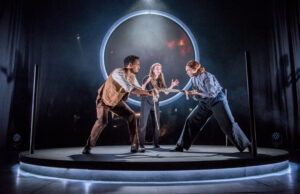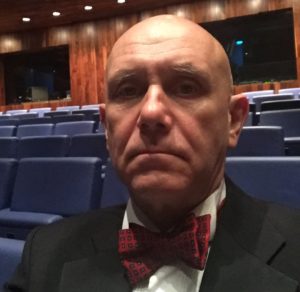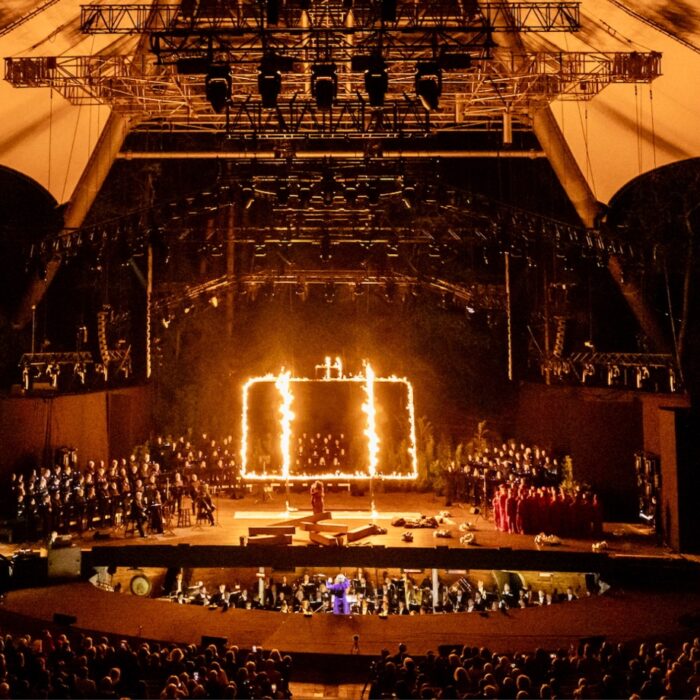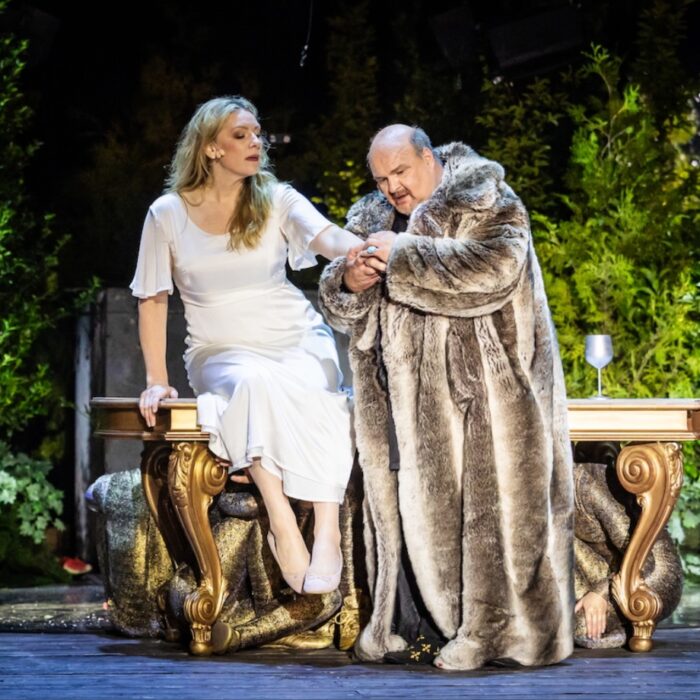
Buxton International Festival 2025 Review: Opera Shorts
Four Fascinating Operas To Showcase Emerging Talent
By Alan Neilson(Photo: Genevieve Girling)
Buxton International Festival’s staging of four new one-act operas as one of its headline events, under the title “Opera Shorts,” was certainly a welcome, if a somewhat risky decision; contemporary opera can be difficult to sell, and artistic success is far from assured. However, for those who were willing to give it a chance, few can have been disappointed with the results.
Four composers and their librettists were each invited to create a short one-act opera lasting approximately 20 minutes on a subject of their own choosing, to be performed in a small theatre seating an audience of approximately 350 people.
They had at their disposal a small orchestral ensemble provided by Northern Ballet Productions, a small chorus and a limited number of soloists. There was a single designer, Elliott Squire, who created a common set consisting of a large round video screen surrounded by a neon light that changed color, in front of which was a small, low-level podium upon which most of the action took place. Props were limited and changed for each production. The lighting and video designs for each opera were provided by Alex Musgrave.
There were two pairs of musical and stage directors: Paul McKenzie and Rebecca Meltzer were responsible for “Life Gets Stretched” and “Disorderly House,” while Berrak Dyer and Marcus Desando oversaw the presentation of “Inevitable” and “Tears Are Not Meant To Stay Inside.”
The four works proved to be very different in subject matter and musical style, but all successfully possessed an easily accessible narrative, although with varying degrees of depth, insight and dramatic strength, while the music for all the pieces was designed to engage the listener, rather than to act primarily as a vehicle for displaying the composers’ skills, which usually ends up alienating the vast majority of the audience.
The ensemble was situated at the back of the performance area, partially hidden by the video screen, and was always dimly lit so that one never had a clear view of the musicians.
Inevitable
First up was composer Carmel Smickersgill and librettist Josh Overton’s “Inevitable,” a neatly constructed work that explored the conflicts, responsibilities and relationships between the generations in a modern society, directed by Desando.
The hand of a large, white-faced clock moving towards the midnight hour is projected onto the circular screen. A mechanical crank sits in the centre of the stage, and a tired, old man, known only as [B], turns its handle. A young girl, named [A], is born into the world and [B] is happy that he can now retire; someone else can now turn back the clock to gain more time before the world ends at midnight. But [A] has better things to do; why bother working to delay the inevitable? [B] believes that she is simply work-shy. They quarrel! However, eventually, they agree to work together to turn back the clock by a few seconds, and in the process almost die of exhaustion. [C] is then born. She is optimistic and excited about the future: something marvelous is surely going to happen at midnight.
It was a beautifully crafted allegory, open to a variety of interpretations depending on how one chose to engage with the characters and one’s political and philosophical standpoints.
Desando’s direction captured the emotional strain that the characters are forced to suffer by having to stave off the inevitable, which Squire’s costume designs further highlighted by having them dressed in yellow boiler suits, emphasizing the drudgery of the daily grind.
Smickersgill’s music, expertly relayed by Dyer and the orchestral ensemble, caught the insistent passage of time through the repetitive rhythm of the drums and the piano that consistently pushed forward, regardless of the characters’ efforts to turn the clock backwards. Short melodic phrases from other instruments were added to create color and harmonic interest. Occasionally, the music broke free into new directions to reflect the onstage atmosphere and emotional tensions.
The three singers engaged convincingly with their roles.
Baritone Christopher Cull was a tired and worn-out [B], who clearly relished the idea of retirement, but whose commitment to turning the crank would not allow him to rest. His singing was clear, articulate and intelligently developed, and his relationship with [A] highlighted their close, albeit fractious, connection.
Mezzo-soprano Beca Davies, playing the role of [A], rolled onto the stage with a relaxed, indifferent attitude, much to [B]’s annoyance, but was soon driven into a state of exhaustion by her efforts to turn back the clock. She created an emotionally strong portrait, in which her voice blended beautifully with the orchestra.
Soprano Julia Mariko captured [C]’s optimistic and positive character with a bright and effusive vocal performance.
Overall, it was a musically convincing, dramatically strong and thought-provoking piece of theatre.
Life Gets Stretched
Martin Green decided to write his own libretto for his composition “Life Gets Stretched’ about the difficulties involved in transitioning into a new society. It was a work with much to admire and was successful on many levels. However, there were also aspects that irritated and distracted.
Two teenagers fleeing a war-torn land arrive in a new country, where they fall in love, marry, and begin to make a new life for themselves. Their ability to adapt to the values and ways of their new home, however, drives a wedge between them. The character called She embraces the opportunities on offer and sets up her own business, with which she becomes obsessed and also very successful. Her husband named He, however, struggles to adapt and cannot understand her behavior. Even the birth of a baby cannot heal the rift that has opened up between them.
The two characters communicated in an imagined language that could not be understood by the audience, nor was it translated in the surtitles. Not only did this create the necessary distance, but it also defined the two characters’ ‘otherness.’ More impressive, however, was Green’s skill in composing music that communicated directly without the necessity of the listener understanding the meaning of the words. Moreover, the two singers, baritone Themba Mvula and soprano Alexandra Meier, both did brilliantly in imbuing the words with meaning, especially in the duets in which their voices combined beautifully and naturally to bring the emotional depth of the words alive.
Green’s score was vibrant and energetic with folksy elements, which reflected his background in folk music. It also informed his writing for the voice for which he created easy-on-the-ear, yet emotionally engaging melodies. The ensemble included an accordion, which added to the folk-like sound. The musical director, McKenzie, elicited a lively, sensitive performance from the ensemble. One negative aspect, however, was the lack of musical momentum, which was constantly interrupted by periods of silence.
Mvula possesses a lyrically attractive, warm voice, which he used intelligently to craft an emotionally sensitive portrait of his character, which captured the sincerity of his love for She and his rising frustrations as their relationship unravelled.
Meier made a particularly strong impression with an expressively compelling interpretation underpinned by a secure technique and tonal beauty.
Along with He and She, there is a third character called Shimble, who acts as a narrator and a purveyor of clichéd new age philosophy doused with earnestly held sentiments. It was a spoken role and proved to be problematic in that the sheer amount of dialogue often overshadowed the musical side of the performance and disrupted the dramatic balance. The problems were exacerbated by the actress playing the role, Tsen Beaver-Day, whose domineering, animated performance came across as preaching and turned the text into a piece of propaganda, as opposed to the very human relationship of He and She.
Squire’s simple designs amounted to little more than an empty stage with colorful video designs that began with images of the destruction caused by war.
The stage director, Meltzer, may have failed to integrate Shimble into the presentation in a balanced, meaningful way, but she handled the relationship between He and She very well: having the couple almost tear the baby apart during a quarrel was a particularly powerful and upsetting image.
Despite its flawed libretto and the structural weaknesses of the work, “Life Gets Stretched” had definite positives: the central narrative was strong, and Green’s skill in writing for the voice and in fleshing out relationships impressed.
Disorderly House
The most traditional of the four works was “Disorderly House,” a tale of an illicit homosexual liaison in 1920s London, by composer Jasper Dommett and librettist Jessica Walker.”
The homosexual dancer Bobby Britt is hosting a party for his friends at his London flat when an uninvited stranger called Robert arrives, who is clearly ill-at-ease with the frivolous, open displays of homosexual behavior that surround him. When Bobby starts to perform Salome’s Dance of the Seven Veils, Robert becomes increasingly aroused and starts to lose his composure. A tense and heated conversation breaks out between the two men before they are interrupted by the police, who arrest everyone present for keeping a disorderly house.
At the heart of the drama is the complex relationship between Bobby and Robert. While Bobby is young, sexually expressive and openly gay, Robert is middle-aged, straight-laced and represses his sexual tendencies. Their meeting triggers feelings of resentment and disgust. Each man can see himself in the other: Robert can see in Bobby what could have been, while Bobby can see in Robert a vision of what is to come – a man all alone, without a family.
The director, Meltzer, along with Squire and the lighting designer, Musgrave, created a strong, convincing visual presentation. The stage was often bathed in a warm orange light, while the video screen conjured up images of the Orient. There was a piano, topped with bottles of alcohol, in the centre of the performance space. The stage was often crowded with guests, who were dressed in flamboyant colorful costumes from the 1920s, while Billy paraded around bare-chested. The scene sizzled with energy.
Dommett’s score drew heavily on the sound world of the 1920s with plenty of allusions on the clarinet to Strauss’ “Salome,” while conjuring up the sultry heat of the East during Billy’s dance. It was wonderfully atmospheric, an effect McKenzie successfully elicited from the orchestral ensemble.
Baritone Egor Sergeev, in the role of Bobby, acted out the part sensitively and imaginatively, moving easily between high camp and less affected behavior; his Dance of the Seven Veils was superbly choreographed, which he executed with the precision of a trained dancer. He loved the limelight and took every opportunity to insert himself into the centre of the drama. His singing was equally expressive, and his confrontation with Robert was essayed with emotional depth.
Christopher Cull captured the pain Robert felt from the moment he entered the house. The shame, the self-loathing, the discomfort and the frustrations were all etched clearly into his voice. Even as he began to lose his inhibitions, there was an uncomfortable nervousness in the voice.
Countertenor Francis Gush, playing the small role of a guest called Harold, took the opportunity to show off his clear, articulate and expressive voice.
Mezzo-soprano Rebecca Anderson put in a solid performance as Constance.
There was also a relatively large role for the chorus, which added to the color and liveliness of the party.
Compared to the other three works, the narrative for “Disorderly House” stood on its own; it did not require a backstory, an explanatory note, or a contextual description. And it was a good tale, well-presented with easily accessible music that successfully created the atmosphere that drew the audience into the onstage world.
Tears Are Not Meant To Stay Inside
South African composer Thandanani Gumede and Zimbabwean librettist Zodwa Nyoni harked back to their African heritage for their composition “Tears Are Not Meant To Stay Inside.”
Nomvula is a black woman who is struggling with her own existence. She feels ignored, unloved and displaced; she is desperate to let go of the pain that this brings and to feel the joy of life again. She thus seeks the help of a traditional African healer, known as a Sangoma, who attempts to cure the illness by realigning her with the spiritual world, which requires cleansing the grief, anger, and exhaustion from the inside through incantations, herbs and communication with the ancestors. To be cured, Nomvula has to follow the path laid out by the Sangoma and allow her tears to flow.
Gumede sought to create a soundscape that used a mix of music from the African and Western classical traditions but “without compromising the integrity and purity of the classical operatic voice.” He also included elements of jazz in an acknowledgement to its African roots. The musical director, Dyer, and the ensemble successfully integrated the various styles in a colorful interpretation, while simultaneously capturing its mixture of moods and atmospheres to promote the drama and delivering its easily accessible melodies.
Squires’ designs, aided by Musgrave’s sensitive lighting, drew a sharp division between modernity with its clean, functional, neutrally colored background and costumes and the warm colors and flamboyant clothing of traditional Africa. The stage director, Desando, built upon these two diametrically opposed worlds to highlight Nomvula’s initial feelings of displacement in the Western world with the deeper, more meaningful connections that are possible in a traditional society, which allowed her to reconnect and express her feelings and heal. Desandro cleverly captured the anonymity of the modern world by having two rows of people between which Nomvula passed without anyone taking note of her, while her healing process was played out with active participation of the Sangoma and an Initiate, whose incantations offered her support.
Soprano Roberta Philip, playing the role of Novula, convincingly created a portrait of a young woman searching for a meaning to her existence and an end to her pain. Her voice displayed a pleasing tone, a sensitivity of expression and an ability to project the voice securely, although her vibrato was a little too wide on occasions.
Soprano Danielle Mahailet, cast as the traditional healer Sangoma, made a fine impression in her bright red and black dress; not only did she look and act out the part superbly, but her voice had a definite spiritual quality that added to her presence.
Baritone Thembe Mvula in the role of the Initiate showed off his attractive, warm timbre, singing incantations in the background.
“Tears Are Not Meant To Stay Inside” proved to be a very simple story, but its clear presentation and accessible, engaging music turned it into an enjoyable work, to which the audience responded very positively.
It proved to be an intense and fascinating 80 minutes of theatre. Four operas in 80 minutes, focused on four very different subjects, boasting plenty of wonderful music and fine young singers, who surely have successful careers ahead of them. There was nothing to dislike about “Opera Shorts.” One can only hope that this becomes an annual event at the festival!



